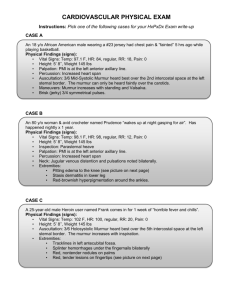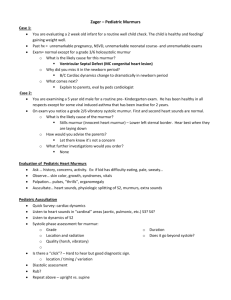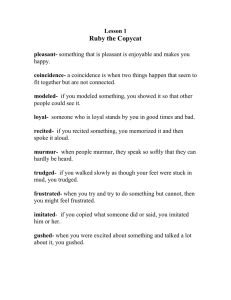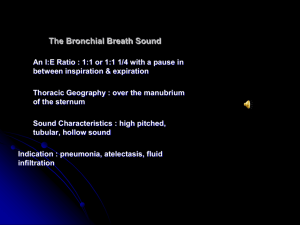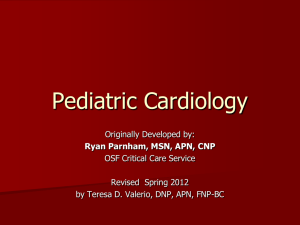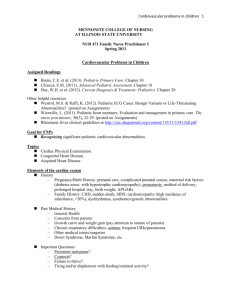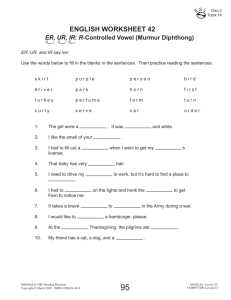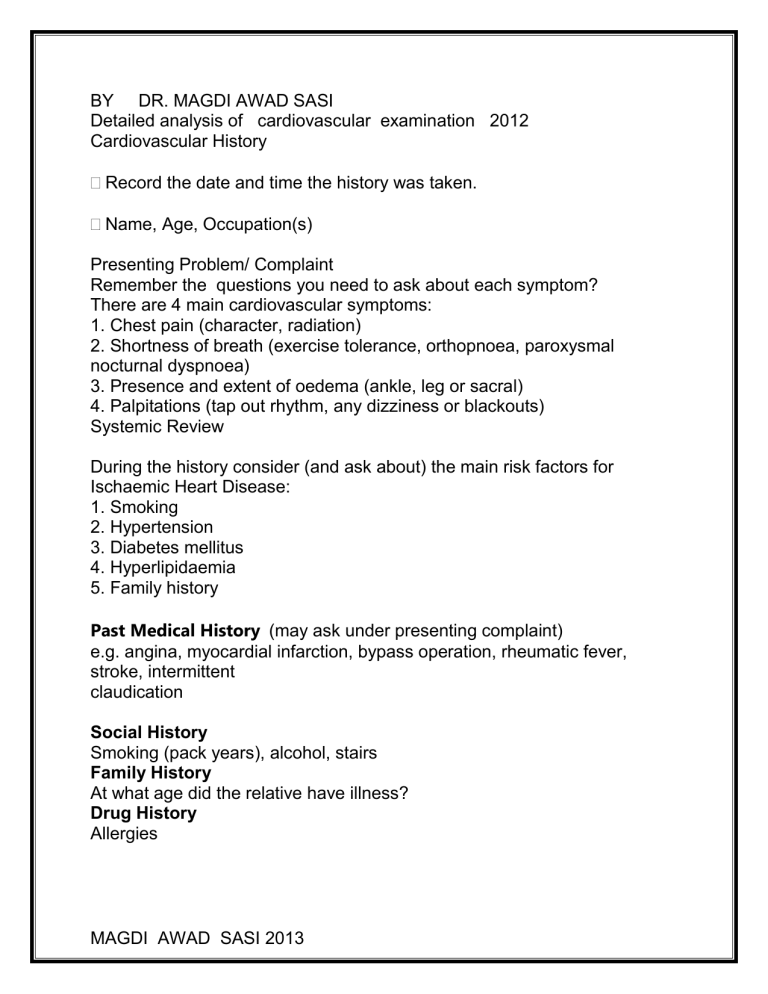
BY DR. MAGDI AWAD SASI Detailed analysis of cardiovascular examination 2012 Cardiovascular History Record the date and time the history was taken. Name, Age, Occupation(s) Presenting Problem/ Complaint Remember the questions you need to ask about each symptom? There are 4 main cardiovascular symptoms: 1. Chest pain (character, radiation) 2. Shortness of breath (exercise tolerance, orthopnoea, paroxysmal nocturnal dyspnoea) 3. Presence and extent of oedema (ankle, leg or sacral) 4. Palpitations (tap out rhythm, any dizziness or blackouts) Systemic Review During the history consider (and ask about) the main risk factors for Ischaemic Heart Disease: 1. Smoking 2. Hypertension 3. Diabetes mellitus 4. Hyperlipidaemia 5. Family history Past Medical History (may ask under presenting complaint) e.g. angina, myocardial infarction, bypass operation, rheumatic fever, stroke, intermittent claudication Social History Smoking (pack years), alcohol, stairs Family History At what age did the relative have illness? Drug History Allergies MAGDI AWAD SASI 2013 INTRODUCTION W - Wash your hands. I - Introduce yourself (full name and role). Greet the patient with their title and surname. P - Permission. Explain that you wish to examine their heart. E - Expose the necessary parts of the patient. Ideally the patient should be undressed from the waist up taking care to ensure the patient is not cold or unnecessarily embarrassed. R - Reposition the patient. In this examination the patient should be supine and reclined at 45 degrees. In the cardiovascular examination a lot of information can be obtained by looking for peripheral signs of cardiovascular disease. The examination is therefore split into a A.peripheral examination and B. examination of the precordium. Adequate exposure and a quiet environment are critical. Peripheral Examination End of the Bed • Examine the patient for signs of breathlessness or distress. • It is also important to look at the surrounding environment for oxygen, fluid restriction signs or GTN spray. Hands • To assess warmth, sweating and whether there is peripheral cyanosis. • Examine the nails for clubbing or signs of infective endocarditis (splinter haemorrhages, Osler’s nodes and Janeway lesions). • Palpate the radial pulse and assess the rate and rhythm. Rate , rhythm , volume, special character, synchronicity, radiofemoral delay Small volume = stenotic lesion mitral and aortic stenosis. Large volume = regurgitation lesion mitral and aortic regurgitation. MAGDI AWAD SASI 2013 Types of pulses Slow rising pulse (delayed up strokes / parvus et tardus) A carotid arterial pulse that is reduced (parvus) and delayed (tardus) argues for aortic valvular stenosis. Occasionally this also may be accompanied by a palpable thrill. If ventricular function is good, a slower upstroke correlates with a higher transvalvular gradient. In left ventricular failure, however, parvus and tardus may occur even with mild aortic stenosis (AS). Pulsus bisferience = AR + AS Pulsus paradocsus = acute sever asthma or cardiac tamponade Pulsus paradoxus is an exaggerated fall in systolic blood pressure during quiet inspiration Pulsus alternans = LVF Pulsus alternans is the alternation of strong and weak arterial pulses despite regular rate and rhythm. Collapsing pulse= hyperdynamic circulation A high volume pulse that hits the fingers suddenly and falls away just as quickly. It is exaggerated by raising the arm well above the level of the heart. This is a sign of aortic regurgitation. The pulse is examined with the arm by the patient’s side; then briskly raise the arm • Measure the blood pressure. If the blood pressure is raised compare both arms. Face • Check eyes for corneal arcus and xanthelasma. • Inspect the conjunctivae for anaemia. • Check for mouth and tongue for central cyanosis. MAGDI AWAD SASI 2013 Check Jugular Venous Pressure (JVP) o With the head resting back on the pillow ask the patient to turn the head to the left while the head of bed is elevated to 45. 1 Think anatomically. The right IJ runs between the two heads (sternal and clavicular) of the sternocleidomastoid muscle (SCM) and up in front of the ear. 2 Take your time. Look at the area in question for several minutes while the patient's head is turned to the left. The carotid artery is adjacent to the IJ, lying just medial to it . The carotid impulse coincides with the palpated radial artery pulsation and is characterized by a single upstroke timed with systole. The venous impulse (at least when the patient is in sinus rhythm and there is no tricuspid regurgitation) has three components a, c and v waves. When these are transmitted to the skin, they create a series of flickers that are visible diffusely within the overlying skin. In contrast, the carotid causes a single up and down pulsation. Furthermore, the carotid is palpable. The IJ is not and can, in fact, be obliterated by applying pressure in the area where it emerges above the clavicle. 3. Shine a pen light tangentially across the neck. This sometimes helps to accentuate the pulsations. 4 . Hepatojugular reflux If you are still uncertain, apply gentle pressure to the right upper quadrant of the abdomen for 5 to 10 seconds. This elicits Hepato-Jugular Reflux which, in pathologic states, will cause blood that has pooled in the liver to flow in a retrograde fashion and fill out the IJ, making the transmitted pulsations more apparent. Make sure that you are looking in the right area when you push as the best time to detect any change in the height of this column of blood is immediately after you apply hepatic pressure. 5 . The Angle of Louis MAGDI AWAD SASI 2013 The angle is the site of the joint which connects the manubrium with the rest of the sternum. First identify the supra-sternal notch, a concavity at the top of the manubrium. Then walk your fingers downward until you detect a subtle change in the angle of the bone, which is approximately 4 to 5 cm below the notch. This is roughly at the level of the 2nd intercostal space. The vertical distance from the top of the column to this angle is added to 5cm, the rough vertical distance from the angle to the right atrium with the patient lying at a 45 degree angle. The sum is an estimate of the CVP.Normal is 7-9 cm. o Look for pulsation along the right internal jugular vein. o The height of the pulsation is measured vertically in cm from the sternal angle. Add 5cm to get the JVP. o You should know how the JVP can be differentiated from carotid pulsation MAGDI AWAD SASI 2013 Explain what you're doing (& why) before doing it . Expose the minimum amount of skin necessary - this requires "artful" use of gown & drapes (males & females) Examining heart & lungs of female patients: Ask pt to remove bra prior (you can't hear the heart well thru fabric) Enlist patient's assistance, asking them to raise their breast to a position that enhances your ability to listen to and palpate the heart Don't rush, act in a callous fashion, or cause pain PLEASE... don't examine body parts thru gown as: 1. It reflects Poor technique 2. You'll miss things 3. You'll lose points on scored exams . MAGDI AWAD SASI 2013 INSPECTION The examination should be conducted in a warm, quiet room. Place the patient in a supine position with the upper body elevated 30 to 45 degrees after all clothing has been removed from the chest. Explain to the patient that you are going to examine the heart. Warm your hands and stethoscope, but warn the patient that your hands may be cool at first. The most comfortable and satisfactory position for most examiners is on the patient's right side The praecordium is the front of the chest overlying the heart. A. Look for abnormal chest shape Normal chest =anterior posterior diameter 1/3- 2/3 of side to side Barrel shaped = anterior posterior equal to side to side COPD, Bronchial asthma , Bronchiectasis Pigeon chest = pectus incavatum= sternum protruded out Funnel chest= pectus excavatum = sternum depressed B. Look for skin , scar , pulsation ,Pacemaker Midline – sternotomy scar – CABG/valve replacement. Left – thoracotomy scar (diagonal from under left breast to left axilla) – mitrial valvectomy for mitrial stenosis. Pacemaker – under skin inferior to left clavicle. Apical pulsation , parasternal pulsation , epigastric pulsation C. Look for respiratory movement Thoraco abdominal in female , Abdominothoracic in male Any change gives a clue to pathological process. D.Look for accessory muscles Contracted sternomastoid , recession of intercostals muscles that gives a clue that the patient is dyspneic or he had a chronic respiratory disease with chronic dyspnea. Note This is the same even for chest inspection that for CVS concentrate on pulsation and for chest lok for respiratory movement. MAGDI AWAD SASI 2013 PALPATION 1.Palpate trachea 2.Apex beat = Point of Maximum Impulse (PMI) It is the lower most , outer most and most forceful pulsation. LOCATE the apex beat accurately with the flat of and fingers of your right hand. Try to pin down the precise location with the tip of your index finger. The normal sized and functioning ventricle will generate a penny sized impulse Count down the ribs from the sternal angle= 2ND intercostals space. The normal apex beat should be in the 5th intercostal space in the mid clavicular line. Decide if the apex beat is normal or displaced. Locate the line “axillary, midclavicular “ , space “ 5th,6th,7th “ and character “ tapping,foreceful heaving or unsustained “. .Apex beat not palpable Normal cause Obesity , thick chest , behind rib Pathological cause barrel chest ,pericardial effusion,dextocardia .Rotating the patient to a left lateral decubitus position tips the heart towards the chest wall and makes the apex beat easier to feel. MAGDI AWAD SASI 2013 1.Mitral stenosis produces a particularly characteristic cardiac apical impulse. The apical impulse often has a sharp tapping nature. This is because the first heart sound is loud because of forceful closure of the mitral valve and this forceful closure is transmitted to the chest wall as a ‘tap’. Same line and same space “ tapping” 2.Aortic stenosis- pressure load “heaving” A forceful or ‘thrusting’ apex, either in the normal position or slightly displaced to 6th intercostals space. This is usually due to concentric LV hypertrophy as a result of conditions such as aortic stenosis or hypertension. same line and change space. “forceful sustained” 3. Mitral and aortic regurgitation- volume load The apical impulse may be displaced to the left and have a more diffuse heaving nature. This is usually when there is volume overload. A similar type of apex beat is often seen when there is sever LV dysfunction and the ventricle is enlarged. If the patien has an audible gallop rhythm this can sometimes also be palpated with a hand placed over the cardiac apex. Line and space changed. “forceful unsustained” D. Constrictive pericarditis , which is rare in many developed countries, but common in the developing world, can produce indrawing of the intercostals spaces during systole because the LV is tethered to the chest wall by the diseased pericardium. Summary: For apex beat , check line , space and character. Palpation of the precordium of a female patient is best done by placing the palm of your right hand directly beneath the patient's left breast such that the edge of your index finger rests against the inferior surface of the breast. Tell that patient what you are about to do (and why) before actually performing this maneuver. Remember that with age tissue turgor often declines, causing the breasts to hang below the level of the heart. MAGDI AWAD SASI 2013 Palpate the 2nd left intercostals space “pulmonary area” for palpable 2nd heart sound which normally not felt. In pulmonary hypertension , the pulmonary artery dilates and produces an impulse in the second left intercostals space and the loud pulmonary component of the S 2 may also be appreciated as a sharp snapping feeling in this area. 3.THRILL It is a palpable vibratory sensation, often compared to the purring of a cat, and typical of murmurs caused by very high pressure gradients. These, in turn, lead to great turbulence and loudness. Hence, thrills are only present in pathologic murmurs whose intensity is greater than 4/6. It should be checked in the four areas by palmer surface of the right hand at the junction of metacarpophalangeal surfaces. The commonest cause of a thrill is aortic stenosis. If present there should be an easily audible murmur present on auscultation. In mitral area= diastolic thrill , in aortic area= systolic thrill MAGDI AWAD SASI 2013 Figure 1 AREAS TO BE PALPATED FOR THRILL 1.Aortic area: 2.Pulmonary area 3.Tricuspid area 4. Mitral area “AA” 2nd parasternal right intercostals space “ PA”:2nd parasternal left intercostals space “TA” : 4th paraeternal left intercostals space “MA” : 5th left intercostals space-apex beat 4.HEAVE Left parasternal (right ventricular) heave A signifi cantly hypertrophied and/or dilated RV will produce an abnormal impulse at the lower end of the sternum, usually to the left side. In a patient with lung disease and an abnormal RV this physical sign may be absent because the over-infl ated lung acts as a cushion between the heart and the chest wall and therefore prevents the impulse being transmitted to the surface. Heaves represent ventricular hypertrophy and feel as if your hand is being lifted of patient’s chest. MAGDI AWAD SASI 2013 Auscultation . Don’t auscultate over clothes or gown. . Warm your hands and stethoscope. . The most satisfactory position for examiner is on the patient's right side. . Become comfortable with your stethoscope. . Learn how to use it correctly bell and diaphragm. . The most important "part" is what sits betwen the ear pieces! . Be isolated from surrounding and keep ear pieces tight to your ears. .4 areas need to be auscultated 2 times change from diaphragm to bell. . 2 positions need to be done by the patient other than supine. . 2 radiation of the murmurs need to be checked. . Start from mitral area “apex beat”. OR aortic area! . start from MA - TA – PA – AA . These areas, although known as the mitral, tricuspid, pulmonary and aortic areas, in fact have no anatomical meaning. They are the key areas where the heart sounds and murmurs radiating from these valves are traditionally considered to be best heard. Be prepared to hunt around slightly to find the optimum position for your stethoscope but don’t move too quickly or you could miss a sound. MAGDI AWAD SASI 2013 Technique of auscultation A. Start from mitral area by putting the diaphragm of stethoscope and Listen systematically to the cardiac cycle i.e. 1st and 2nd heart sounds (S1 and 2) and listen in the systolic and diastolic intervals for added sounds and murmurs. Time events with simultaneous palpation of the carotid. B. Roll your patient slightly onto his left side and listen in the 5th ICS with the bell for the low frequency mid diastolic murmur of mitral stenosis. (Listen in full expiration). C. Auscultate in the axilla with the diaphragm for radiation and comparative loudness of a systolic murmur. (e.g. the pan systolic murmur of mitral regurgitation radiates to the axilla.) D. Go to TA then PA then AA ask patient to sit , lean forward and exhale the air to check AA and listen at left lower sternal edge for high frequency diastolic murmur of aortic regurgetation E. auscultate with the diaphragm over both carotids for bruits and radiation of murmurs, (the ejection systolic murmur of aortic stenosis radiates to the neck.) MAGDI AWAD SASI 2013 F. Use both the bell and diaphragm appropriately in the 4 areas – That the bell should only be placed lightly on the skin. The bell at the apex for low frequency sounds (i.e. murmurs) The diaphragm at the base for high frequency sounds. HEART SOUNDS Heart sounds are discrete bursts of auditory vibrations of varying intensity (loudness), frequency (pitch), quality, and duration. Start by listening to the heart sounds. To help you differentiate between the heart sounds they should be timed against the carotid pulse. SUMMARY S1 =1st heart sound best heard in MA Muffled with MR as it is masked by pansystolic murmur Very loud in MS with rumbling diastolc murmur Timed with carotid pulsation S2 =2nd heart sound heard in AA Loud in PA in pulmonary HTN, loud in AA in systemic HTN Timed with carotid pulsation “delay” Soft A2 in AS , AR S3 = Left ventricular failure-gallop rhythm S4 = noncompliant ventricle LVH S3 AND S4 DIASTOLIC SOUNDS , LOW PITCHED. MAGDI AWAD SASI 2013 S1 & S2 ARE NORMAL SOUNDS . S3&S4 ARE PATHOLOGICAL. • The first heart sound is . The sound of the mitral and tricuspid valves closing .Systolic events tend to occur at the same time as the carotid pulse . Loudest at the apex. The S1 is muffled when there is an increased amount of tissue between the heart and the stethoscope, as occurs with pleural effusion, pericardial effusion, emphysema, pneumothorax, and obesity. Conditions associated with a loud S1 include the following: Increased transvalvular gradient (MS, TS, atrial myxoma) Increased force of ventricular contraction (tachycardia, hyperdynamic states [ie, anemia, fever, thyrotoxicosis, exercise, inotropic agents]) Shortened PR interval - Tachycardia, preexcitation syndromes (ie, Wolff-Parkinson-White [WPW] syndrome) Conditions associated with diminished intensity of S1 include the following: Inappropriate apposition of the AV valves (ie, mitral regurgitation [MR], tricuspid regurgitation [TR], dilated cardiomyopathy) Prolonged PR interval (ie, bradycardia, heart block, digitalis toxicity) Decreased force of ventricular contraction (ie, cardiomyopathy, myocarditis, myxedema, myocardial infarction [MI]) Increased calcification of the AV valve (ie, calcific MS, postirradiation) Increased distance from the heart (ie, obesity, emphysema, pleural effusion, pericardial effusion) MAGDI AWAD SASI 2013 SO , S1 CAN BE HELPFUL FOR EVALUTING THE SEVERITY OF VALVULAR LESION. . • The second heart sound .Closure of the aortic and pulmonary valves at end of systole. .Follows the apical impulse and carotid pulsation. . Best heard at the upper left sternal edge using the diaphragm of the stethoscope. A2 is best heard at the aortic area (second right intercostal space); P2 is best heard at the pulmonary area. S2 is a high-pitched sound heard best with the diaphragm of the stethoscope. The intensity depends on valvular factors, the transvalvular gradient, mechanical factors, and size of the great vessels. The intensity of A2 is increased in Systemic hypertension, Coarctation of the aorta, Aortic aneurysm, Thin individuals, and when the aorta is closer to the anterior chest wall as may occur with tetralogy of Fallot and transposition of the great arteries (TGA). The intensity of A2 is decreased with decreased aortic diastolic pressure ( AR), with improper valvular apposition ( AR or aortic dissection), calcific immobile valves ( calcific aortic stenosis [AS]), and decreased systemic arterial pressure. The intensity of P2 is increased with pulmonary arterial hypertension Split S2 Normally, the aortic valve closes slightly before the pulmonary valve. This difference is more pronounced with inspiration due to increased RV stroke volume. The fixed-split S2- ASD, right heart failure MAGDI AWAD SASI 2013 Third Heart Sound The third heart sound (S3) is a low-pitched, early diastolic sound audible during the rapid entry of blood from the atrium to the ventricle. When arising from the LV, it is best audible at the apex with the patient in left lateral decubitus position with breath held at end expiration. When it is of RV origin, S3 is best audible at the left lower sternal border or the xiphoid with the patient in supine position. These are best heard with the bell of the stethoscope. Conditions associated with pathological S3 include the following: A. Systolic and/or diastolic ventricular dysfunction 1. Ischemic heart disease 2. MR or TR 3. Sysetmic and pulmonary hypertension 4. Acute aortic regurgitation 5. Chronic AR with systolic dysfunction B.Hyperkinetic states - Anemia, fever, pregnancy, thyrotoxicosis, AV fistula C.Volume overload - Renal failure Fourth Heart Sound The fourth heart sound (S4) is a late diastolic sound that corresponds to late ventricular filling through active atrial contraction. It is a low-intensity sound heard best with the bell of the stethoscope. When of LV origin, S4 is best heard at the apex with the patient in the left lateral decubitus position at end expiration. When of RV origin, it is heard best at the left lower sternal border. Maneuvers that increase the preload increase the intensity of S4 by increasing the separation of S4 from S1. Active atrial contraction is necessary for the generation of S4. Thus, S4 is not audible with atrial fibrillation or flutter. Some of the conditions associated with S4 include the following: Ventricular hypertrophy - LV hypertrophy (systemic hypertension, hypertrophic cardiomyopathy, AS); RV hypertrophy (pulmonary hypertension, pulmonary stenosis [PS]) Ischemic heart disease - Acute MI,angina Ventricular aneurysm Hyperkinetic states that cause forceful atrial contraction MAGDI AWAD SASI 2013 Both S3 and S4 need to be differentiated from splitting of the normal heart sounds. With splitting, the heart sounds are high pitched and best audible with the diaphragm, whereas the S3 or S4 are low-pitched sounds best audible with the bell of the stethoscope Is there any audible sound other than heart sounds? MURMURS 1.‘‘Inching’’ the stethoscope (i.e., slowly dragging it from site to site) can be the best way to avoid missing important findings. 2. From MA TO TA THEN PA OT AA or THE REVERSE AA. 3. Murmurs are common in MA AND AA THAT IS LEFT SIDE. Definition: The production of murmurs results from turbulent flow across valves. Three main factors have been attributed to cause a murmur: (1) high flow rate through normal or abnormal orifices (2) forward flow through a constricted or irregular orifice or into a dilated vessel or chamber, (3) backward or regurgitant flow through an incompetent valve. When evaluating a heart murmur, it is important to know the timing of the murmur in the cardiac cycle, the location, the duration, character, configuration, radiation, aggravating maneuvers, and diminishing maneuvers. Types of murmurs: 1.Systolic (holosystolic, early/middle/late systolic) 2.Diastolic (early/middle/late) or 3.Continuous (ie, present in both systole and diastole). All diastolic murmurs and any systolic murmur above grade 2 in severity requires further evaluation with echocardiography. MAGDI AWAD SASI 2013 TIME The timing of the murmur is determined by palpating the carotid pulse while listening to the murmur. The carotid upstroke corresponds to the onset of systole. LOCATION This is the area of the heart where the murmur is heard the loudest. While auscultating, one should concentrate on the apex, pulmonary area, tricuspid, and aortic areas, in addition to the axilla, base of the heart, and left fourth ICS for evidence of radiation of murmur. INTENSITY: The intensity of the murmur depends on the volume of blood flow across the valve and the pressure gradient across which the blood flow occurs. What is the Levine system for grading the intensity of murmurs? The intensity or loudness of a murmur is traditionally graded by the Levine system from 1/6 to 6/6. Increased intensity usually reflects increased flow turbulence. Thus, a louder murmur is more likely to be pathologic and severe. Grade I - Heard in a quiet room by an expert examiner Grade II - Heard by most examiners Grade III - Loud murmur without thrill Grade IV - Loud murmur with a thrill Grade V - Thrill with a very loud murmur audible with stethoscope placed lightly over the chest Grade VI - Thrill with a very loud murmur audible even with the stethoscope slightly away from the chest MAGDI AWAD SASI 2013 Quality/character: Different murmurs have different qualities, such as harsh, blowing, rumbling, musical. Pitch: This can be high or low pitched depending on the frequency of the murmur. The high-pitched sounds are best audible with a diaphragm and the low-pitched sounds with the bell. MAGDI AWAD SASI 2013 Radiation: Murmurs tend to radiate to certain specific areas that are often characteristic of a particular murmur. The murmur of MR radiates to the axilla or base of the heart, depending on which leaflet is involved. In the case of AS, the murmur radiates in the direction of the jet of turbulent blood (ie, radiates to the carotids). Similarly, the aortic regurgitant murmur tends to radiate along the left sternal border. Configuration: This corresponds to the shape of murmur intensity over time. It can be a plateau, decrescendo, crescendo-decrescendo, or crescendo murmur. Maneuver affect on murmur: 1.Affect of respiration The murmurs generated from the right side of the heart increase in intensity with inspiration by increasing the venous return to right side. , Murmurs arising from the left side of the heart become more prominent with expiration as blood is forced from lung to the heart. 2.Standing up: This causes a peripheral pooling of blood and a net decrease in venous return. Most murmurs are thus decreased in intensity upon standing, except that of hypertrophic obstructive cardiomyopathy (HOCM) and MVP, which become more prominent. 3.Squatting: Squatting causes an increase in the afterload and venous return (ie, preload). The net effect is an increase in intensity of all the murmurs, except those associated with MVP and HOCM, which become less prominent with squatting. 4.Hand grip: Hand grip is a form of isometric exercise and increases the afterload, arterial pressure, LV volume, and LV pressure. The net effect of these changes is complex and variable. Murmurs of MR, AR, and VSD worsen with hand grip, while those of HOCM and MVP are less prominent. MAGDI AWAD SASI 2013 Cardiac cycle As a rule , the stenosis will be evident once blood flow through the valve and the valve is opened that with associated turbulent flow. The 2nd rule is the regurgitation will be evident once there is no blood flow through the valve and valve closed In systole, left and right ventricles contract Aortic valve and pulmonary valves opened Mitral and tricuspid valves closed Aortic and pulmonary valves opened. If there is stenosis “AS/PS” , ejection systolic murmur will be heard in aortic area/ pulmonary area which is harsh high pithched loud of crescendo- decrescendo in configuration as blood is pumped with high amount during systole which became more audible by sitting leaning and in full expiration in AS. Mitral valve and tricuspid valves closed. If there is regurgitation “MR/TR”, pansystolic murmur will be heard in mitral area and tricuspid area which is blowing and high pitched plateau in configuration which became more audible by telt to left side in apex beat in the expiration and radiate to left axilla in MR. In diastole, left and rig ventricles relaxed. Mitral and tricuspid valves opened. Aortic and pulmonary valves closed . Mitral and tricuspid valves opened . If there is stenosis “MS/TS”, mid diastolic murmur will be heard in mitral area and tricuspid area which is low-pitched rumbling , best heard with the bell of the stethoscope placed over the cardiac apex with the patient in the left lateral position in mitral stenosis in expiration with loud S1. Aortic and pulmonary valves closed. If there is regurgitation, “AR/PR” early diastolic murmur will be heard in aortic area and pulmonary area which is high-pitched sound, is decrescendo in configuration , and is most audible at the left sternal border or the right second ICS just to the right of sternum, with the patient leaning forward at end expiration in AR. AS/PS = EJCETION SYSTOLIC MURMU MR/TR = PANSYSTOLIC MURMUR AR/PR = EARLY DIASTOLIC MURMUR MS/TS =MID DIASTOLIC MURMUR MAGDI AWAD SASI 2013 Systolic murmurs; 1. Pansystolic murmurMitral regurgitation Tricuspid regurgitation Ventricular septal defect These murmurs last throughout ventricular systole. They usually start at S1 and proceed through S2; the intensity of the murmur may overshadow both valve closure sounds. These murmurs are typically produced by emptying of the high-pressure ventricle during systole into chambers that have lower pressure at that time (the atria with MR or TR or the right ventricle in the case of VSD). The murmur of MR is blowing and high pitched and is best heard at the apex with radiation to the axilla or the base of the heart. It is usually plateau in configuration. The MR murmur is increased during expiration, passive leg raising, squatting, and handgrip and decreased in intensity with inspiration, Valsalva, and standing. The radiation of the murmur depends on which leaflet is involved. A murmur generated by the deformity of anterior leaflet radiates more toward the axilla, thoracic spine, and scapula, while a murmur arising from posterior leaflet involvement radiates to the base of the heart Severe MR . The presence of S3 . Signs of pulmonary hypertension and right heart failure The murmur of TR is best heard at the left lower sternal border. It is a blowing high-pitched murmur heard that increases in intensity with inspiration (Carvallo sign). It can result primarily from involvement of the tricuspid valve or secondarily from pulmonary hypertension. When due to pulmonary hypertension, it is associated with a loud P2. In VSD with normal pulmonary arterial pressures, a holosystolic murmur can be heard over the left lower sternal border at the level of the third and fourth ICSs. This murmur depends on the orifice size of the septal defect. The smaller the defect, the greater the intensity of the murmur. MAGDI AWAD SASI 2013 2.Ejection systolic murmur “mid to late systole” Aortic o Obstructive Supravalvular - Supravalvular AS, aortic coarctation Valvular - AS, aortic sclerosis Subvalvular - HOCM o Increased flow, hyperkinetic states, aortic regurgitation, complete heart block o Dilatation of the ascending aorta, aortitis, atheroma Pulmonary o Obstructive Supravalvular - Pulmonary artery stenosis Valvular - Pulmonary valve stenosis Subvalvular - Infundibular stenosis o Increased flow, hyperkinetic states, left-to-right shunt o These murmurs are usually associated with ventricular outflow tract obstruction (which can be valvular, supravalvular, or subvalvular) or an abnormal amount of blood flow across normal valves as can happen in hyperdynamic states (hyperthyroidism, fever, pregnancy, anemia, renal failure). AS/PS The murmur associated with valvular stenosis (AS or PS) is usually a harsh murmur which is crescendo- decrescendo in configuration and high pitched. AS-associated murmurs are most audible at the right upper sternal border/right third ICS with the patient in the upright position and breath held at end expiration. In some cases, it is audible at the apex, in which case it can be confused with the murmur of MR. Some of the findings that help delineate the murmur of MR from that of AS include an audible S1, forceful apex, radiation to carotids, changes with atrial fibrillation, and post-PVC accentuation. The AS murmur usually radiates to the carotid arteries. MAGDI AWAD SASI 2013 Early diastolic murmurs Are produced by either AR or pulmonary regurgitation. ar The AR murmur is a soft high-pitched sound, is decrescendo in configuration, and is most audible at the left sternal border or the right second ICS just to the right of sternum, with the patient leaning forward at end expiration. The murmur radiates to the left lower sternal border if it is due to primary valve disease. In patients with aortic root disease, the murmur may radiate to the right sternal border. The murmur increases in intensity during expiration and decreases in intensity with hand grip. The S2 is usually muffled with AR. PR The murmur of pulmonary regurgitation is best audible at the pulmonary area. The character, quality, and pitch of the murmur vary depending on the presence or absence of pulmonary hypertension. In the presence of pulmonary hypertension, it is a high-pitched, decrescendo murmur also known as a Graham Steell murmur. S2 is usually loud in association with pulmonary regurgitation. In the absence of pulmonary hypertension, it is a low-pitched crescendo-decrescendo murmur. Mid- to late diastolic murmurs These murmurs are produced by the blood flow across stenotic AV valves. MS produces a low-pitched, mid-diastolic, rumbling murmur with presystolic accentuation, best heard with the bell of the stethoscope placed over the cardiac apex with the patient in the left lateral position. S1 is loud. The murmur usually follows an OS, and the interval between the A2 and OS is inversely proportional to the severity of obstruction. The murmur of MS is increased in intensity with expiration and maneuvers that increase cardiac output, such as exercise. The presystolic accentuation results from atrial contraction in late diastole and is absent in patients with atrial fibrillation. The duration of murmur corresponds to the period in which the LA-LV diastolic pressure gradient is maintained. This duration correlates with the severity of obstruction; the longer the murmur duration, the more severe the MS (provided the diastolic filling time is not shortened, as may happen in tachycardia) except in high cardiac output and pulmonary htpertension. D/D OF MID DIASTOLIC MURMUR: 1. 2. 3. 4. Tricuspid stenosis=tricuspid area Atrial myxoma- change by position Austin Flint murmur- due to AR Carey Coombs murmur-rhematic heart disease MAGDI AWAD SASI 2013 Continuous Murmurs PDA Coronary arteriovenous fistula Ruptured sinus of Valsalva aneurysm Aortopulmonary window Anomalous left coronary artery from the pulmonary artery Bronchial collateral circulation Opening Snap The opening snap (OS) is a high-pitched diastolic sound produced by rapid opening of the mitral valve in MS or TS. When mitral in origin, it is best heard at the apex following the aortic sound A2, with the patient in left lateral decubitus position. The time difference between the A2 and OS has a diagnostic implication. The closer the OS is to A2, the more severe the stenosis. The OS signifies when the left atrial pressure exceeds the LV diastolic pressure and marks the beginning of blood entry into the LV from the LA. The more severe the stenosis, the greater the LA pressure and the lesser the LA-LV early diastolic pressure gradient, leading to an early opening of the mitral valve. In general, the relation between A2 and the OS depends on LV pressure at A2 closure, LA pressure at A2 closure, and the rate of LV pressure decline. Pericardial rub It indicates pericardial inflammation. • Inflammation of the pericardial membrane or pleural sac at the 3rd and 4th interspace at the left sternal border. Louder during inspiration • Scratchy, like sandpaper being used, a match being struck, or leather squeaking . • Sound present when the epicardial & pericardial surfaces, roughened by inflammation, slide over one another during atrial & ventricular systole & during the passive motion of rapid ventricular filling. MAGDI AWAD SASI 2013 • 3 components – Atrial Systolic (A) – Ventricular Systolic (V) – Ventricular Diastolic (D) Percardial Knock • Sharp, high-pitched sound present in 90% or more of patients with constrictive pericarditis • Heard in diastole • Occurs .09 to .12 sec after S3 • Occurs after Heart Surgery, radiation therapy, viral infection, TB pericarditis • Diaphragm of the stethoscope listen at the lower left sternal border Tumor Plops • Clues to a Myxoma – Cardiac silhouette on X-Ray consistent with atrial enlargement – An ECG showing signs of LA enlargement – Light-headedness – A very short presystolic murmur – Extra sound in diastole • Left Atrial Tumors – Loud, low-frequency thud heard in early diastole & caused by abrupt movements of the tumor inside the LA – It strikes the wall of the chamber or comes to a sudden halt as the pedicle reaches the limit its stretch MAGDI AWAD SASI 2013 SUMMARY SHEET OF CVS EXAMINATION 1. INSPECTION Chest deformity Skin ,scars , pulsation, vessels Respiratory movements Accessory muscles of respiration 2. PALPATION Trachea Apex beat- line , space , character Thrill- MA , TA ,PA & AA. Heave - left parasternal 3. AUSCULTATION Start in mitral area by diaphragm and listen for S1 ,S2 ,M For murmur , site ,time ,radiation, character, grade ,pitch. Tilt pt to left lateral and use the bell to here diastole in MA Change the bell to diaphragm to auscultate axilla for PSM Inch to TA and check S2 and ask pt to hold in inspiration Inch to PA to hear P2 and murmurs if present Concentrate on AA and ask pt to sit , lean ,and full expiration Lastly check carotids by diaphragm for systolic radiation MAGDI AWAD SASI 2013 MAGDI AWAD SASI 2013
